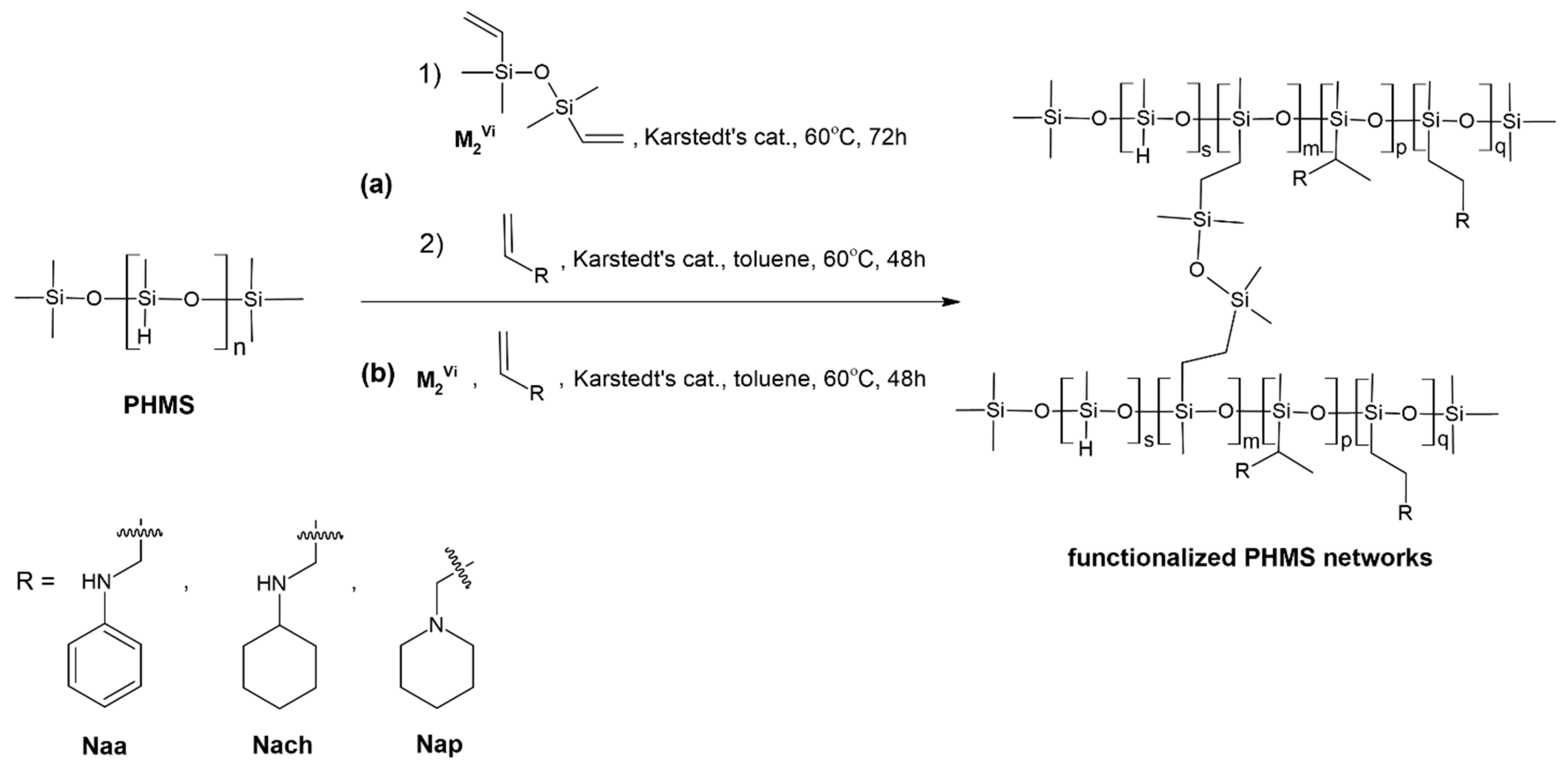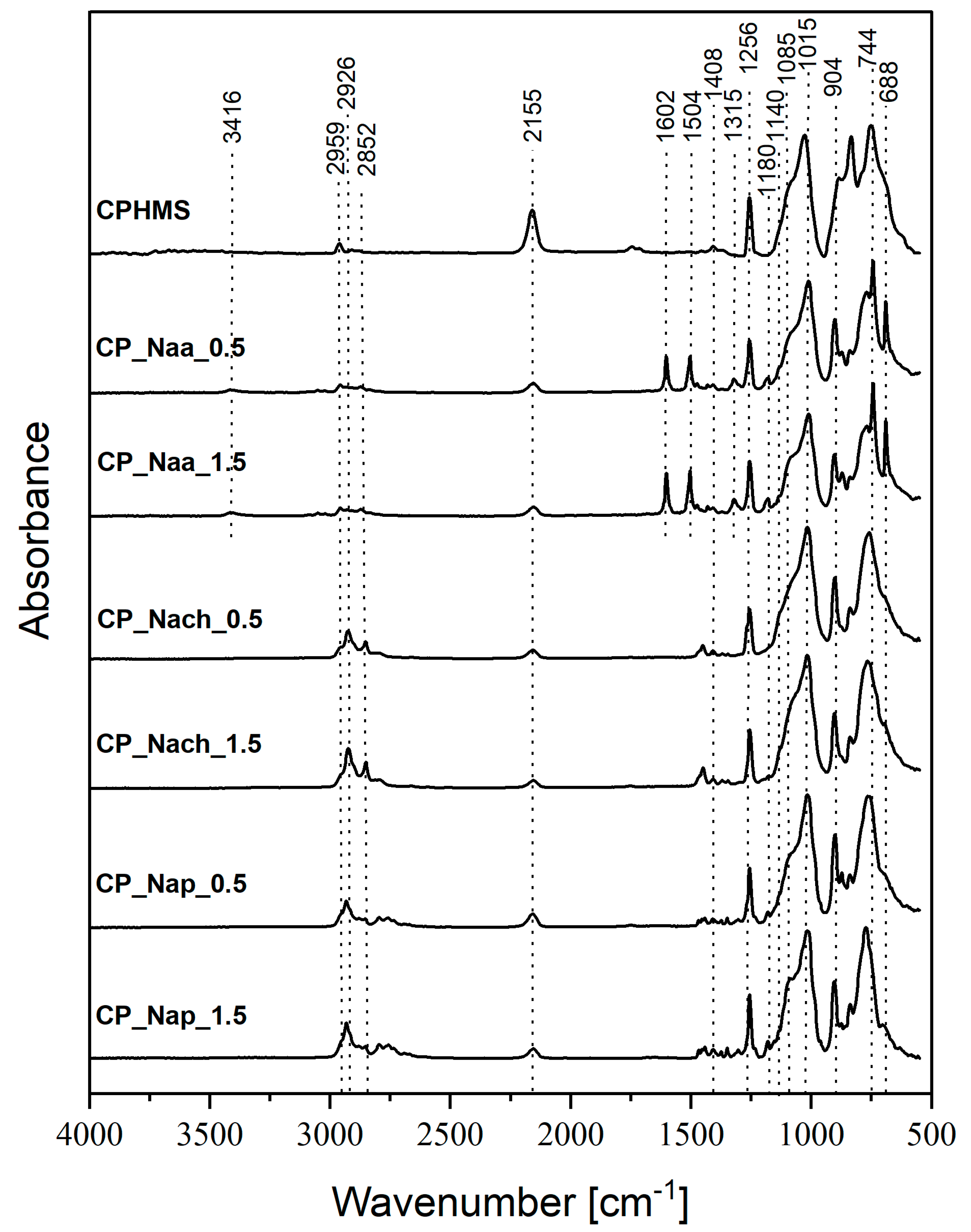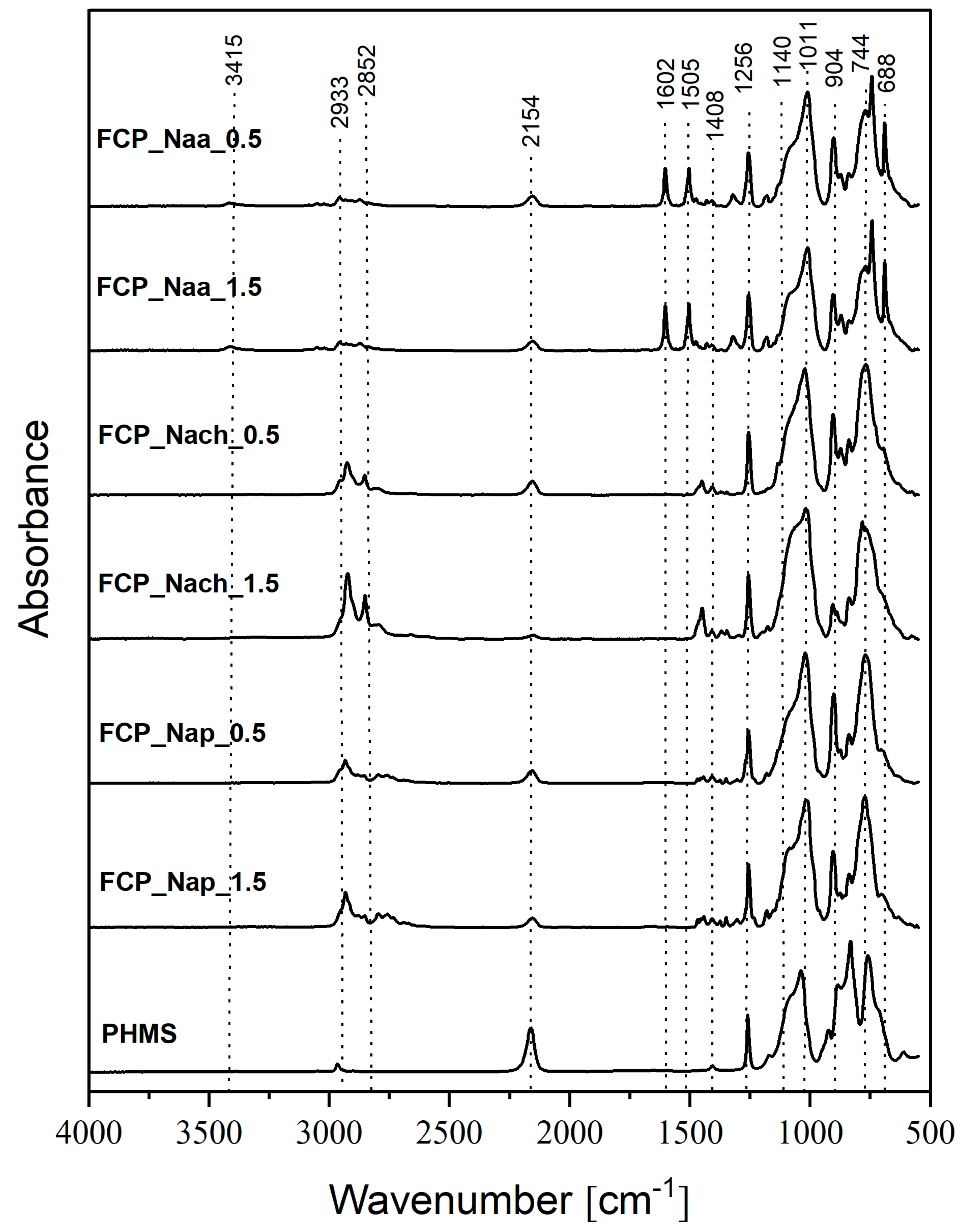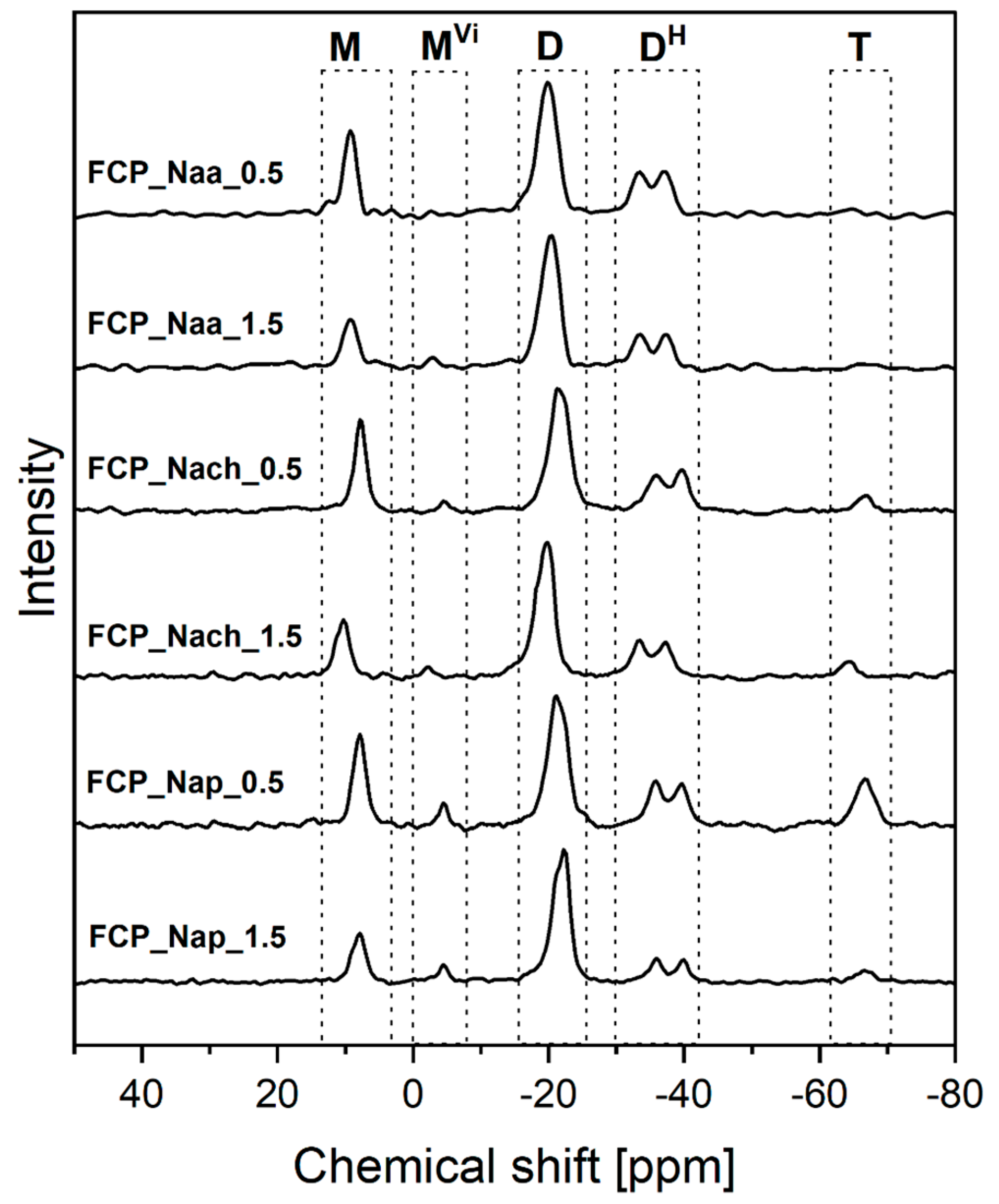Polysiloxane Networks Modified by Nitrogen-Containing Organic Compounds
Abstract
1. Introduction
2. Results and Discussion
2.1. Two-Step Procedure
2.2. One-Step Procedure
2.3. Two-Step and One-Step Procedures—Comparison Based on Conversion of Si-H Groups
- Taking into account that M units originated exclusively from the cross-linking process (Figure 1), the fraction of Si-H groups participating in this reaction was assumed to be equal to the share of the signal attributed to M units in the 29Si MAS-NMR spectrum of a given sample.
- The share of the signal corresponding to Si-H groups functionalized with an amine was assumed to be equal to the difference between the shares of D and M units in the 29Si MAS-NMR spectrum of a given sample. This was because the same number of M and D units were formed upon polymer cross-linking (Figure 1). Thus, excessive D units were attributed to the functionalization process.
- The sum of the fractions of the Si-H groups not taking part in PHMS cross-linking was calculated as the difference: [100% − the share of M units in the 29Si MAS-NMR spectrum of a given sample]. To obtain fractions of Si-H groups involved in individual reactions or staying intact, this difference was divided into parts proportional to the shares of the respective signals in the 29Si MAS-NMR spectrum of a given sample.
- Additionally, conversion degrees of the Si-H groups preserved in the materials after polymer cross-linking in individual reactions were calculated. This was performed as in point 3 but assuming the difference: [100% − the share of M units in the 29Si MAS-NMR spectrum of a given sample] as 100%.
3. Materials and Methods
3.1. Materials
3.2. Cross-Linking of PHMS with M2Vi (CPHMS)
3.3. Functionalization of CPHMS with Nitrogen-Containing N-Allyl Compounds
3.4. Simultaneous Functionalization of PHMS with Nitrogen-Containing N-Allyl Compounds and Cross-Linking Using M2Vi
3.5. Characterization Methods
4. Conclusions
Supplementary Materials
Author Contributions
Funding
Institutional Review Board Statement
Informed Consent Statement
Data Availability Statement
Acknowledgments
Conflicts of Interest
References
- Dvornic, P.R. Thermal properties of polysiloxanes. In Silicon Containing Polymers; Jones, R.G., Ando, W., Chojnowski, J., Eds.; Springer: Dordrecht, The Netherlands, 2000; pp. 185–212. [Google Scholar] [CrossRef]
- Yilgör, E.; Yilgör, I. Silicone Containing Copolymers: Synthesis, Properties and Applications. Prog. Polym. Sci. 2014, 39, 1165–1195. [Google Scholar] [CrossRef]
- Wolf, M.P.; Salieb-Beugelaar, G.B.; Hunziker, P. PDMS with Designer Functionalities–Properties, Modifications Strategies, and Applications. Prog. Polym. Sci. 2018, 83, 97–134. [Google Scholar] [CrossRef]
- Mark, J.E. Some interesting things about polysiloxanes. Accounts Chem. Res. 2004, 37, 946–953. [Google Scholar] [CrossRef]
- Curtis, J.; Steichen, S.D. Silicones. In Biomaterials Science: An Introduction to Materials in Medicine, 4th ed.; Ratner, B.D., Hoffmann, A.S., Schoen, F.J., Lemons, J.E., Eds.; Elsevier Academic Press: London, UK, 2013; pp. 109–124. [Google Scholar]
- Boutevin, B.; Guida-Pietrasanta, F.; Ratsimihety, A. Side Group Modified Polysiloxanes. In Silicon-Containing Polymers; Jones, R.G., Ando, W., Chojnowski, J., Eds.; Springer Nature: Dordrecht, The Netherlands, 2000; pp. 79–112. [Google Scholar] [CrossRef]
- Troegel, D.; Stohrer, J. Recent advances and actual challenges in late transition metal catalyzed hydrosilylation of olefins from an industrial point of view. Coord. Chem. Rev. 2011, 255, 1440–1459. [Google Scholar] [CrossRef]
- Mazurek, M.H. Silicones. In Comprehensive Organometallic Chemistry III. From Fundamentals to Applications; Mingos, D.M.P., Crabtree, R.H., Eds.; Elsevier: New York, NY, USA, 2007; Volume 7, pp. 651–977. [Google Scholar] [CrossRef]
- Chruściel, J.J. Most Important Biomedical and Pharmaceutical Applications of Silicones. Materials 2025, 18, 2561. [Google Scholar] [CrossRef]
- Colombo, P.; Mera, G.; Riedel, R.; Sorarù, G.D. Polymer-Derived Ceramics: 40 Years of Research and Innovation in Advanced Ceramics. J. Am. Ceram. Soc. 2010, 97, 1805–1837. [Google Scholar] [CrossRef]
- Marciniec, B. Comprehensive Handbook on Hydrosilylation, 1st ed.; Elsevier: Oxford, UK, 1992. [Google Scholar] [CrossRef]
- Chechelska-Noworyta, A.; Mrówka, J.; Owińska, M.; Hasik, M. Application of Spectroscopic Methods in the Studies of Polysiloxanes, Cubic Oligomeric Silsesquioxanes, and Spherosilicates Modified by Organic Functional Groups via Hydrosilylation. In Molecular Spectroscopy-Experiment and Theory, Challenges and Advances in Computational Chemistry and Physics; Koleżyński, A., Król, M., Eds.; Springer Nature: Cham, The Netherlands, 2018; Volume 26, pp. 361–400. [Google Scholar] [CrossRef]
- Brook, M.A. Silicon in Organic, Organometallic, and Polymer Chemistry; John Wiley & Sons: Hoboken, NJ, USA, 2000. [Google Scholar]
- Wójcik-Bania, M.; Łącz, A.; Nyczyk-Malinowska, A.; Hasik, M. Poly(methylhydrosiloxane) networks of different structure and content of Si-H groups: Physicochemical properties and transformation into silicon oxycarbide ceramics. Polymer 2017, 130, 170–181. [Google Scholar] [CrossRef]
- Stochmal, E.; Strzezik, J.; Krowiak, A. Physicochemical and catalytic properties of polysiloxane network–Pt systems. RSC Adv. 2017, 7, 26342–26360. [Google Scholar] [CrossRef]
- Urayama, K.; Kawamura, T.; Kohjiya, S. Structure–mechanical property correlations of model siloxane elastomers with controlled network topology. Polymer 2009, 50, 347–356. [Google Scholar] [CrossRef]
- Baumann, T.F.; Jones, T.V.; Wilson, T.; Saab, A.P.; Maxwell, R.S. Synthesis and characterization of novel PDMS nanocomposites using POSS derivatives as cross-linking filler. J. Polym. Sci. Part A Polym. Chem. 2009, 47, 2589–2596. [Google Scholar] [CrossRef]
- Zhang, C.E.; Zhang, C.; Cui, X.; Sun, J.; Ding, R.; Zhang, Q.; Xu, Y. Transparent and dense ladder-like alkylene-bridged polymethylsiloxane coating with enhanced water vapor barrier property. ACS Appl. Mater. Interfaces 2015, 7, 22157–22165. [Google Scholar] [CrossRef]
- Wysopal, A.; Owińska, M.; Stodolak-Zych, E.; Gackowski, M.; Hasik, M. Poly(hydromethylsiloxane) Networks Functionalized by N-allylaniline. Int. J. Mol. Sci. 2025, 26, 6700. [Google Scholar] [CrossRef] [PubMed]
- El-Ashgar, N.M.; El-Nahhal, I.M.; Chehimi, M.M.; Babonneau, F.; Livage, J. Extraction of Co, Ni, Cu, Zn and Cd ions using 2-aminophenylaminopropylpolysiloxane. Environ. Chem. Lett. 2009, 8, 311–316. [Google Scholar] [CrossRef]
- Zawartka, W.; Pośpiech, P.; Cypryk, M.; Trzeciak, A.M. Palladium supported on aminopropyl–functionalized polymethylsiloxane microspheres: Simple and effective catalyst for the Suzuki–Miyaura C–C coupling. J. Mol. Catal. A Chem. 2015, 407, 230–235. [Google Scholar] [CrossRef]
- Zawartka, W.; Pośpiech, P.; Cypryk, M.; Trzeciak, A.M. Carbonylative Suzuki-Miyaura coupling catalyzed by palladium supported on aminopropyl polymethylsiloxane microspheres under atmospheric pressure of CO. J. Mol. Catal. A Chem. 2016, 417, 76–80. [Google Scholar] [CrossRef]
- Wang, Z.; Beletskiy, E.V.; Lee, S.; Hou, X.; Wu, Y.; Li, T.; Kung, M.C.; Kung, H.H. Amine-functionalized siloxane oligomer facilitated synthesis of subnanometer colloidal Au particles. J. Mater. Chem. A 2014, 3, 1743–1751. [Google Scholar] [CrossRef]
- Mizerska, U.; Fortuniak, W.; Chojnowski, J.; Hałasa, R.; Konopacka, A.; Werel, W. Polysiloxane cationic biocides with imidazolium salt (ImS) groups, synthesis and antibacterial properties. Eur. Polym. J. 2009, 45, 779–787. [Google Scholar] [CrossRef]
- Zhang, Q.; Liu, H.; Chen, X.I.; Zhan, X.; Chen, F. Preparation, surface properties, and antibacterial activity of a poly(dimethylsiloxane) network containing a quaternary ammonium salt side chain. J. App. Polym. Sci. 2014, 132, 41725. [Google Scholar] [CrossRef]
- Mizerska, U.; Fortuniak, W.; Chojnowski, J.; Turecka, K.; Konopacka, A.; Werel, W. Antimicrobial Siloxane Statistical and Graft Copolymers Substituted with t-Butylamine and t-Butylammonium Biocidal Functions. J. Inorg. Organomet. Polym. Mater. 2010, 20, 554–563. [Google Scholar] [CrossRef]
- Lin, Y.; Liu, Q.; Cheng, L.; Lei, Y.; Zhang, A. Synthesis and antimicrobial activities of polysiloxane-containing quaternary ammonium salts on bacteria and phytopathogenic fungi. React. Funct. Polym. 2014, 85, 36–44. [Google Scholar] [CrossRef]
- He, S.; Hou, M.; Shan, S.; Li, R.; Yu, N.; Lin, Y.; Zhang, A. Synthesis and anti-bacterial/fungal activities of amphiphilic polysiloxanes primary ammonium salts. React. Funct. Polym. 2022, 183, 105495. [Google Scholar] [CrossRef]
- Hayashi, T.; Shimojima, A. Self-healing materials based on dynamic properties of siloxane networks. J. Sol-Gel Sci. Technol. 2025, 1–15. [Google Scholar] [CrossRef]
- Fortuniak, W.; Chojnowski, J.; Slomkowski, S.; Pospiech, P.; Kurjata, J. Route to hydrophilic, hydrophobic and functionalized cross-linked polysiloxane microspheres. Polymer 2013, 54, 3156–3165. [Google Scholar] [CrossRef]
- Bradley, C.A.; Yuhas, B.D.; McMurdo, M.J.; Tilley, T.D. Functionalized Silicone Nanospheres: Synthesis, Transition Metal Immobilization, and Catalytic Applications. Chem. Mater. 2008, 21, 174–185. [Google Scholar] [CrossRef]
- Mieczyńska, E.; Borkowski, T.; Cypryk, M.; Pospiech, P.; Trzeciak, A.M. Palladium supported on triazolyl–functionalized polysiloxane as recyclable catalyst for Suzuki–Miyaura cross–coupling. Appl. Catal. A Gen. 2014, 470, 24–30. [Google Scholar] [CrossRef]
- Madsen, F.B.; Javakhishvili, I.; Jensen, R.E.; Daugaard, A.E.; Hvilsted, S.; Skov, A.L. Synthesis of telechelic vinyl/allyl functional siloxane copolymers with structural control. Polym. Chem. 2014, 5, 7054–7061. [Google Scholar] [CrossRef]
- Min, C.; Pu, Q.; Yang, L.; Fan, H. Synthesis, film morphology, and performance on cotton substrates of dodecyl/piperazine functional polysiloxane. J. Appl. Polym. Sci. 2013, 131, 40186. [Google Scholar] [CrossRef]
- Ziętkowska, K.; Przybyszewski, B.; Kozera, R.; Boczkowska, A.; Liszewska, M.; Pakuła, D.; Sztorch, B.; Przekop, R.E. Modifying transparent silicone-epoxy hybrid coating with functionalized polysiloxanes for anti-icing applications. Colloids Surf. A Physicochem. Eng. Asp. 2025, 727, 138216. [Google Scholar] [CrossRef]
- Moriyama, N.; Miki, Y.; Nagasawa, H.; Tsuru, T.; Ito, K.; Hasegawa, Y.; Kanezashi, M. Simple strategy for the fabrication of thin amine-polysiloxane hybrid membranes supported by microfiltration membranes. Ind. Eng. Chem. Res. 2025, 64, 9773–9781. [Google Scholar] [CrossRef]
- Arcos-Casarrubias, J.A.; Vázquez-Torres, H.; Granados-Olvera, J.A.; Cedeño, A.J.; CervantesUc, J.M. Viscoelastic behavior and toughness of the DGEBA epoxy resin with 1,2-diaminocyclohexane: Effect of functionalized poly(dimethylsiloxane), diglycidyl ether, PDMS-DGE, pre-reacted with 1,2-diaminocyclohexane. Polym. Bull. 2021, 79, 2871–2901. [Google Scholar] [CrossRef]
- Guerra-Contreras, A.; Villegas, A.; Ramírez-Oliva, E.; Cervantes, J. Characterization and study of properties in a polar solvent of a functionalized and quaternized poly(dimethylsiloxane-co-methyl-hydridosiloxane). Silicon 2015, 9, 525–533. [Google Scholar] [CrossRef]
- Lei, Y.; Zhou, S.; Dong, C.; Zhang, A.; Lin, Y. PDMS tri-block copolymers bearing quaternary ammonium salts for epidermal antimicrobial agents: Synthesis, surface adsorption and non-skin-penetration. React. Funct. Polym. 2018, 124, 20–28. [Google Scholar] [CrossRef]
- Kanjilal, B.; Noshadi, I.; McCutcheon, J.R.; Asandei, A.D.; Parnas, R.S. Allylcyclohexylamine functionalized siloxane polymer and its phase separated blend as pervaporation membranes for 1,3-propanediol enrichment from binary aqueous mixtures. J. Membr. Sci. 2015, 486, 59–70. [Google Scholar] [CrossRef]
- Fortuniak, W.; Mizerska, U.; Chojnowski, J.; Basinska, T.; Slomkowski, S.; Chehimi, M.M.; Konopacka, A.; Turecka, K.; Werel, W. Polysiloxanes With Quaternary Ammonium Salt Biocidal Functions and Their Behavior When Incorporated Into a Silicone Elastomer Network. J. Inorg. Organomet. Polym. 2011, 21, 576–589. [Google Scholar] [CrossRef]
- Ciubotaru, B.-I.; Zaltariov, M.-F.; Dascalu, M.; Bele, A.; Bargan, A.; Cazacu, M. Amino-functionalized silicones processed as porous dual covalent/supramolecular networks for pressure sensing. React. Funct. Polym. 2024, 194, 105792. [Google Scholar] [CrossRef]
- Chechelska-Noworyta, A.; Owińska, M.; Hasik, M. Hydrosilylation of nitrogen-containing organic compounds: Model studies. J. Organomet. Chem. 2019, 898, 120866. [Google Scholar] [CrossRef]
- Owińska, M.; Chechelska-Noworyta, A.; Olejniczak, Z.; Hasik, M. Functionalization of polyhydromethylsiloxane with nitrogen-containing organic compounds. J. Polym. Res. 2021, 28, 169. [Google Scholar] [CrossRef]
- Shultz, A.R. Crosslinking. In Encyclopedia of Polymer Science and Technology; Mark, H.F., Gayload, N.G., Bikales, N.M., Eds.; Wiley: London, UK, 1966; Volume 4, pp. 333–398. [Google Scholar]
- Socrates, G. Infrared and Raman Characteristic Group Frequencies, 3rd ed.; John Wiley & Sons Inc: New York, NY, USA, 2004. [Google Scholar]
- Marsmann, H.C. Silicon-29 NMR. In eMagRes; Wiley: Hoboken, NJ, USA, 2011. [Google Scholar] [CrossRef]
- Hou, Y.I.; Zhu, G.; Cui, J.; Wu, N.; Zhao, B.; Xu, J.; Zhao, N. Superior Hard but Quickly Reversible Si-O-Si Network Enables Scalable Fabrication of Transparent, Self-Healing, Robust, and Programmable Multifunctional Nanocomposite Coatings. J. Am. Chem. Soc. 2022, 144, 436–445. [Google Scholar] [CrossRef]
- Hou, Y.I.; Zhu, G.; Catt, S.O.; Yin, Y.; Xu, J.; Blasco, E.; Zhao, N. Closed-loop recyclable silica-based nanocomposites with multifunctional properties and versatile processability. Adv. Sci. 2023, 10, 2304147. [Google Scholar] [CrossRef]
- Wagen, C.; Wagen, A. Efficient and Accurate pKa Prediction Enabled by Pre-Trained Machine-Learned Interatomic Potentials. ChemRxiv 2024. [Google Scholar] [CrossRef]
- Adams, R.; Mahan, J.E. Basicity studies of tertiary vinyl amines. J. Am. Chem. Soc. 1942, 64, 2588–2593. [Google Scholar] [CrossRef]
- Haynes, W.M. (Ed.) CRC Handbook of Chemistry and Physics: A Ready-Reference Book of Chemical and Physical Data, 90th ed.; CRC Press: Boca Raton, FL, USA, 2009. [Google Scholar]
- Belot, V.; Corriu, R.J.P.; Leclercq, D.; Mutin, P.H.; Vioux, A. Thermal Redistribution Reactions in Crosslinked Polysiloxanes. J. Polym. Sci. Part A Polym. Chem. 1992, 30, 613–623. [Google Scholar] [CrossRef]
- Campostrini, R.; D’Andrea, G.; Carturan, G.; Ceccato, R.; Sorarù, G.D. Pyrolysis study of methyl-substituted Si—H containing gels as precursors for oxycarbide glasses, by combined thermogravimetry, gas chromatographic and mass spectrometric anal-ysis. J. Mater. Chem. 1996, 6, 585–594. [Google Scholar] [CrossRef]
- Hourlier, D.; Venkatachalam, S.; Ammar, M.-R.; Blum, Y. Pyrolytic conversion of organopolysiloxanes. J. Anal. Appl. Pyrolysis 2017, 123, 296–306. [Google Scholar] [CrossRef]
- Gussoni, M.; Greco, F.; Mapelli, M.; Vezzoli, A.; Ranucci, E.; Ferruti, P.; Zetta, L. Elastomeric Polymers. 2. NMR and NMR Imaging Characterization of Cross-Linked PDMS. Macromolecules 2002, 35, 1722–1729. [Google Scholar] [CrossRef]





| Sample | Conversion Degree of the Si-H Groups [%] a | 29Si MAS-NMR: Chemical Shift in the Signal b [ppm] (Share [%], Δ-Share Difference with Respect to the Starting Spectrum) | |||||
|---|---|---|---|---|---|---|---|
| M Units | MVi Units | D Units | DH Units | DOH Units | T Units | ||
| CPMHS | - | 8.0 (16) | - | −19.6 (16) | −33.3; −37.5 (64) | - | −65.7 (4) |
| CP_Naa_0.5 | 64.0 | 8.9 (15, Δ = −1) | - | −20.1 (40, Δ = +24) | −35.7 (25, Δ = −39) | −58.4 (5) | −67.4 (15, Δ = +11) |
| CP_Naa_1.5 | 69.1 | 8.9 (16, Δ = 0) | - | −20.5 (56, Δ = +40) | −33.7; −37.4 (28, Δ = −36) | - | - |
| CP_Nach_0.5 | 74.8 | 8.2 (18, Δ = +2) | - | −21.1 (44, Δ = +28) | - | - | −66.5 (38, Δ = +34) |
| CP_Nach_1.5 | 78.3 | 8.1 (18, Δ = +2) | - | −21.4 (62, Δ = +46) | - | - | −66.6 (20, Δ = +16) |
| CP_Nap_0.5 | 62.8 | 8.4 (15, Δ = −1) | - | −20.6 (36, Δ = +20) | −36.6 (23, Δ = −41) | - | −66.1 (26, Δ = +22) |
| CP_Nap_1.5 | 53.5 | 8.4 (17, Δ = +1) | - | −20.4 (34, Δ = +18) | −37.2 (15, Δ = −49) | - | −66.4 (34, Δ = +30) |
| Sample | Contents of Elements [wt.%] | ||||
|---|---|---|---|---|---|
| N | C | H | SiO c | ||
| calc. a | Found b | ||||
| CP_Naa_0.5 | 4.06 | 3.58 (88.2) | 44.71 | 8.25 | 43.46 |
| CP_Naa_1.5 | 5.89 (6.87) | 4.94 (84.3) | 52.37 | 8.73 | 33.97 |
| CP_Nach_0.5 | 3.99 | 3.28 (82.2) | 42.08 | 12.53 | 42.11 |
| CP_Nach_1.5 | 5.71 (6.67) | 5.18 (82.7) | 51.90 | 15.59 | 27.33 |
| CP_Nap_0.5 | 4.16 | 3.03 (72.8) | 39.26 | 12.51 | 45.20 |
| CP_Nap_1.5 | 6.07 (7.15) | 2.57 (42.3) | 34.68 | 11.63 | 51.12 |
| Sample | Conversion Degree of the Si-H Groups [%] a | 29Si MAS-NMR: Chemical Shift in the Signal b [ppm] (Share [%]; Functionalization Degree c) | |||||
|---|---|---|---|---|---|---|---|
| M Units | MVi Units | D Units | DH Units | DOH Units | T Units | ||
| FCP_Naa_0.5 | 79.5 | 8.6 (21) | - | −20.5 (51; 30) | −34.1; −37.9 (28) | - | - |
| FCP Naa_1.5 | 80.3 | 8.6 (17) | −3.6 (2) | −20.8 (57; 40) | −34.1; −38.0 (24) | - | - |
| FCP_Nach_0.5 | 74.0 | 8.1 (21) | −4.3 (1) | −21.3 (49; 28) | −35.5; −39.4 (25) | - | −65.8 (4) |
| FCP_Nach_1.5 | 91.7 | 8.1 (16) | −4.1 (2) | −21.2 (64; 48) | −35.0; −38.8 (14) | - | −65.9 (4) |
| FCP_Nap_0.5 | 76.0 | 8.2 (19) | −4.1 (3) | −21.0 (43; 24) | −35.4; −39.2 (20) | - | −66.3 (15) |
| FCP_Nap_1.5 | 83.3 | 8.4 (16) | −4.1 (5) | −21.5 (60; 44) | −35.5; −39.5 (12) | - | −66.3 (5) |
| Sample | Contents of Elements [wt.%] | ||||
|---|---|---|---|---|---|
| N | C | H | SiO c | ||
| calc. a | Found b | ||||
| FCP_Naa_0.5 | 4.06 | 4.02 (99.0) | 50.54 | 8.30 | 37.14 |
| FCP_Naa_1.5 | 5.86 (6.87) | 5.61 (95.7) | 59.86 | 8.94 | 25.59 |
| FCP_Nach_0.5 | 3.99 | 3.73 (93.5) | 47.67 | 10.99 | 37.61 |
| FCP_Nach_1.5 | 5.71 (6.67) | 5.35 (93.7) | 58.62 | 12.30 | 23.73 |
| FCP_Nap_0.5 | 4.16 | 3.23 (77.6) | 41.25 | 9.98 | 45.54 |
| FCP_Nap_1.5 | 6.07 (7.15) | 4.95 (81.5) | 50.49 | 11.04 | 33.52 |
| Type of Si-H Groups | Fraction in the Sample [%] (Conversion Degree a [%]) | |||||
|---|---|---|---|---|---|---|
| CP_Naa_0.5 vs. FCP_Naa_0.5 | CP_Naa_1.5 vs. FCP_Naa_1.5 | CP_Nach_0.5 vs. FCP_Nach_0.5 | CP_Nach_1.5 vs. FCP_Nach_1.5 | CP_Nap_0.5 vs. FCP_Nap_0.5 | CP_Nap_1.5 vs. FCP_Nap_1.5 | |
| Cross-linked | 15 vs. 21 | 16 vs. 17 | 18 vs. 21 | 18 vs. 16 | 15 vs. 19 | 17 vs. 16 |
| Functionalized | 30.5 (36) vs. 41 (52) | 49 (59) vs. 50 (61) | 33 (41) vs. 38 (48) | 56 (69) vs. 60 (71) | 25 (30) vs. 31 (39) | 21 (26) vs. 56 (67) |
| Converted to DOH units | 6 (7) vs. 0 | 0 vs. 0 | 0 vs. 0 | 0 vs. 0 | 0 vs. 0 | 0 vs. 0 |
| Converted to T units | 18 (21) vs. 0 | 0 vs. 0 | 49 (59) vs. 6 (7) | 26 (31) vs. 5 (6) | 32 (37) vs. 20 (24) | 43 (51) vs. 6.5 (8) |
| Converted to MVi units | 0 vs. 0 | 0 vs. 3 | 0 vs. 1 | 0 vs. 2 | 0 vs. 4 | 0 vs. 6.5 |
| Unreacted | 30.5 vs. 38 | 35 vs. 30 | 0 vs. 34 | 0 vs. 17 | 28 vs. 26 | 19 vs. 15 |
Disclaimer/Publisher’s Note: The statements, opinions and data contained in all publications are solely those of the individual author(s) and contributor(s) and not of MDPI and/or the editor(s). MDPI and/or the editor(s) disclaim responsibility for any injury to people or property resulting from any ideas, methods, instructions or products referred to in the content. |
© 2025 by the authors. Licensee MDPI, Basel, Switzerland. This article is an open access article distributed under the terms and conditions of the Creative Commons Attribution (CC BY) license (https://creativecommons.org/licenses/by/4.0/).
Share and Cite
Chechelska-Noworyta, A.; Owińska, M.; Hasik, M. Polysiloxane Networks Modified by Nitrogen-Containing Organic Compounds. Int. J. Mol. Sci. 2025, 26, 11133. https://doi.org/10.3390/ijms262211133
Chechelska-Noworyta A, Owińska M, Hasik M. Polysiloxane Networks Modified by Nitrogen-Containing Organic Compounds. International Journal of Molecular Sciences. 2025; 26(22):11133. https://doi.org/10.3390/ijms262211133
Chicago/Turabian StyleChechelska-Noworyta, Aleksandra, Maria Owińska, and Magdalena Hasik. 2025. "Polysiloxane Networks Modified by Nitrogen-Containing Organic Compounds" International Journal of Molecular Sciences 26, no. 22: 11133. https://doi.org/10.3390/ijms262211133
APA StyleChechelska-Noworyta, A., Owińska, M., & Hasik, M. (2025). Polysiloxane Networks Modified by Nitrogen-Containing Organic Compounds. International Journal of Molecular Sciences, 26(22), 11133. https://doi.org/10.3390/ijms262211133






